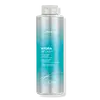What's inside
What's inside
 Benefits
Benefits

 Concerns
Concerns

 Ingredients Side-by-side
Ingredients Side-by-side

Water
Skin ConditioningSodium Laureth Sulfate
CleansingCocamide Mipa
EmulsifyingDisodium Cocoamphodiacetate
CleansingGlycol Stearate
EmollientSodium Chloride
MaskingButyrospermum Parkii Butter
Skin ConditioningLaurdimonium Hydroxypropyl Hydrolyzed Keratin
Skin ConditioningArginine Hcl
Skin ConditioningPhosphatidylcholine
EmulsifyingRosa Canina Fruit Oil
EmollientCocos Nucifera Oil
MaskingHydrolyzed Algin
Sea Water
HumectantChlorella Vulgaris Extract
Skin ConditioningSodium Cetearyl Sulfate
CleansingCocamidopropyl Betaine
CleansingGuar Hydroxypropyltrimonium Chloride
Skin ConditioningCetyl Alcohol
EmollientAcrylates/Aminoacrylates/C10-30 Alkyl PEG-20 Itaconate Copolymer
Emulsion StabilisingDimethicone
EmollientSodium Citrate
BufferingCitric Acid
BufferingPEG-4 Laurate
EmulsifyingDisodium EDTA
Polyquaternium-7
DMDM Hydantoin
PreservativeIodopropynyl Butylcarbamate
PreservativeSodium Benzoate
MaskingMethylchloroisothiazolinone
PreservativeMethylisothiazolinone
PreservativePhenoxyethanol
PreservativePotassium Sorbate
PreservativeLinalool
PerfumingLimonene
PerfumingParfum
MaskingCI 42090
Cosmetic ColorantCI 60730
Cosmetic ColorantCI 19140
Cosmetic ColorantWater, Sodium Laureth Sulfate, Cocamide Mipa, Disodium Cocoamphodiacetate, Glycol Stearate, Sodium Chloride, Butyrospermum Parkii Butter, Laurdimonium Hydroxypropyl Hydrolyzed Keratin, Arginine Hcl, Phosphatidylcholine, Rosa Canina Fruit Oil, Cocos Nucifera Oil, Hydrolyzed Algin, Sea Water, Chlorella Vulgaris Extract, Sodium Cetearyl Sulfate, Cocamidopropyl Betaine, Guar Hydroxypropyltrimonium Chloride, Cetyl Alcohol, Acrylates/Aminoacrylates/C10-30 Alkyl PEG-20 Itaconate Copolymer, Dimethicone, Sodium Citrate, Citric Acid, PEG-4 Laurate, Disodium EDTA, Polyquaternium-7, DMDM Hydantoin, Iodopropynyl Butylcarbamate, Sodium Benzoate, Methylchloroisothiazolinone, Methylisothiazolinone, Phenoxyethanol, Potassium Sorbate, Linalool, Limonene, Parfum, CI 42090, CI 60730, CI 19140
Water
Skin ConditioningSodium Lauroyl Methyl Isethionate
CleansingCocamidopropyl Betaine
CleansingAcrylates Copolymer
Glycol Distearate
EmollientGlycerin
HumectantPolysorbate 20
EmulsifyingPhenoxyethanol
PreservativeSodium Chloride
MaskingTrisodium Ethylenediamine Disuccinate
Laureth-4
EmulsifyingSodium Hydroxide
BufferingSodium Benzoate
MaskingPolyquaternium-10
Ethylhexylglycerin
Skin ConditioningPersea Gratissima Oil
Skin ConditioningAleurites Moluccanus Seed Oil
Skin ConditioningCitric Acid
BufferingLactic Acid
BufferingWater, Sodium Lauroyl Methyl Isethionate, Cocamidopropyl Betaine, Acrylates Copolymer, Glycol Distearate, Glycerin, Polysorbate 20, Phenoxyethanol, Sodium Chloride, Trisodium Ethylenediamine Disuccinate, Laureth-4, Sodium Hydroxide, Sodium Benzoate, Polyquaternium-10, Ethylhexylglycerin, Persea Gratissima Oil, Aleurites Moluccanus Seed Oil, Citric Acid, Lactic Acid
Ingredients Explained
These ingredients are found in both products.
Ingredients higher up in an ingredient list are typically present in a larger amount.
Citric Acid is an alpha hydroxy acid (AHA) naturally found in citrus fruits like oranges, lemons, and limes.
Like other AHAs, citric acid can exfoliate skin by breaking down the bonds that hold dead skin cells together. This helps reveal smoother and brighter skin underneath.
However, this exfoliating effect only happens at high concentrations (20%) which can be hard to find in cosmetic products.
Due to this, citric acid is usually included in small amounts as a pH adjuster. This helps keep products slightly more acidic and compatible with skin's natural pH.
In skincare formulas, citric acid can:
While it can provide some skin benefits, research shows lactic acid and glycolic acid are generally more effective and less irritating exfoliants.
Most citric acid used in skincare today is made by fermenting sugars (usually from molasses). This synthetic version is identical to the natural citrus form but easier to stabilize and use in formulations.
Read more about some other popular AHA's here:
Learn more about Citric AcidCocamidopropyl Betaine is a fatty acid created by mixing similar compounds in coconut oil and dimethylaminopropylamine, a compound with two amino groups.
This ingredient is a surfactant and cleanser. It helps gather the dirt, pollutants, and other impurities in your skin to be washed away. It also helps thicken a product and make the texture more creamy.
Being created from coconut oil means Cocamidopropyl Betaine is hydrating for the skin.
While Cocamidopropyl Betaine was believed to be an allergen, a study from 2012 disproved this. It found two compounds in unpure Cocamidopropyl Betaine to be the irritants: aminoamide and 3-dimethylaminopropylamine. High-grade and pure Cocamidopropyl Betaine did not induce allergic reactions during this study.
Learn more about Cocamidopropyl BetainePhenoxyethanol is a preservative that has germicide, antimicrobial, and aromatic properties. Studies show that phenoxyethanol can prevent microbial growth. By itself, it has a scent that is similar to that of a rose.
It's often used in formulations along with Caprylyl Glycol to preserve the shelf life of products.
Sodium Benzoate is a preservative. It's used in both cosmetic and food products to inhibit the growth of mold and bacteria. It is typically produced synthetically.
Both the US FDA and EU Health Committee have approved the use of sodium benzoate. In the US, levels of 0.1% (of the total product) are allowed.
Sodium benzoate works as a preservative by inhibiting the growth of bacteria inside of cells. It prevents the cell from fermenting a type of sugar using an enzyme called phosphofructokinase.
It is the salt of benzoic acid. Foods containing sodium benzoate include soda, salad dressings, condiments, fruit juices, wines, and snack foods.
Studies for using ascorbic acid and sodium benzoate in cosmetics are lacking, especially in skincare routines with multiple steps.
We always recommend speaking with a professional, such as a dermatologist, if you have any concerns.
Learn more about Sodium BenzoateChances are, you eat sodium chloride every day. Sodium Chloride is also known as table salt.
This ingredient has many purposes in skincare: thickener, emulsifier, and exfoliator.
You'll most likely find this ingredient in cleansers where it is used to create a gel-like texture. As an emulsifier, it also prevents ingredients from separating.
There is much debate on whether this ingredient is comedogenic. The short answer - comedogenic ratings don't tell the whole story. Learn more about comegodenic ratings here.
The concensus about this ingredient causing acne seems to be divided. Research is needed to understand if this ingredient does cause acne.
Scrubs may use salt as the primary exfoliating ingredient.
Learn more about Sodium ChlorideWater. It's the most common cosmetic ingredient of all. You'll usually see it at the top of ingredient lists, meaning that it makes up the largest part of the product.
So why is it so popular? Water most often acts as a solvent - this means that it helps dissolve other ingredients into the formulation.
You'll also recognize water as that liquid we all need to stay alive. If you see this, drink a glass of water. Stay hydrated!
Learn more about Water